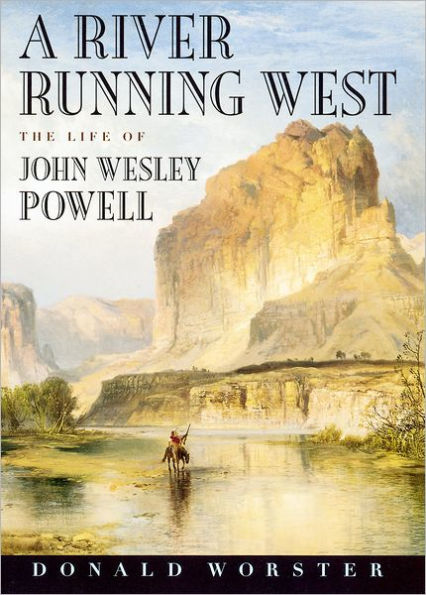Read an Excerpt
Chapter 5
Down the Great Unknown
The Green River begins among the high, persistent glaciers and ice-cold tarns of the Wind River Range in Wyoming. At first a mere trickle from the rooftop of the continent, it swells to muddy grandeur along its 730 miles through alpine meadows, sagebrush flats, spectacular sandstone canyons, and alkaline wastes. Entering Utah, it bends around the east-west trending Uinta Mountains, forming Browns Park and the deep chasms of what is now called Dinosaur National Monument. Resuming its course south, the river flows through the Uinta Basin and the dry Gunnison Valley to a confluence with the Grand. Altogether the Green falls nine thousand feet, many of them foaming white-water rapids. The river's name may derive from the brush growing along its banks, offering a brilliant contrast to the often blasted country on either side, or from the name of a St. Louis businessman who dealt in furs. The legendary heart of the fur trade and the scene of its annual rendezvous, the Green was known to trappers by an Indian name, the Seedskadee.
Powell had assumed throughout his 1867-68 explorations that the Grand was the true source of the Colorado River and the logical starting point for penetrating the western country. In 1875, however, he acknowledged that it was the Green, not the Grand, that is "the proper continuation of the Colorado," and he was right. The Green is four hundred miles longer than the Grand, drains an area nearly twice as large, and therefore by the rules of geographical nomenclature ought properly to be considered the upper mainstem. In 1921 the state of Colorado, with support from the U.S. Congress, perversely declared the Grand to be that mainstem, as though chauvinism could repeal the facts of nature. Powell, whatever his earlier confusion, wisely chose to launch his exploring boats into the waters of the Green, though he had not tracked its point of origin among the Wind River glaciers.
Powell had another, more compelling reason for starting out on the Green in his journey down the Colorado River. Early in 1869 the transcontinental railroad had crossed the Green, making it possible to unload boats directly from a flatbed car into water flowing to the Gulf of California. While Lieutenant Ives and others had tried to push heavy steamboats upstream from the Gulf, until the Grand Canyon blocked their passage, Powell had decided that a better strategy was to put small wooden boats into the upper basin and descend on the power of the current. He later explained to the English writer William Bell that he had talked with Indians and white hunters, consulted the Mormons in Utah, read reports of the government surveys, and with his own eye examined the upper reaches from its banks and canyon walls, until he was convinced that he could successfully go down the entire river in small boats. But first he needed to find money to buy those boats.
When he and Emma left their winter quarters on the White River to go back east, via Green River City (or Stanton), Emma went to Detroit to stay with her parents while Wes stopped in Chicago. There took his boat sketches to a master boatmaker, Thomas Bagley, whose workshop was located where Clark Avenue meets the Chicago River. Powell ordered four boats made to his carefully considered specifications. Three of them were to be twenty-one feet long, four feet wide, and two feet deep, each made of oak, double-ribbed with wineglass transoms (they strongly resembled ferry tenders used on Lake Michigan), and each divided into three compartments, the fore and aft compartments decked and watertight in anticipation of rough waves. The fourth boat was to be a shorter, lighter craft of pine, sixteen feet long and similarly divided into compartments. The first three needed to be heavy and rugged in order to carry food supplies through dangerous, rock-filled rapids, while the smaller boat should be fast and maneuverable to pilot the expedition through treacherous places.
While the boats were under construction, Powell went after a renewal of funding from his benefactors. The 1868 resolution of congress, allowing him to draw free rations from western army posts for twenty-five men, was still in effect; he could take part of his meat rations in the form of cash, which allowed him to hire four hunters to supply his party with fresh meat along the way so they did not have to subsist on bacon only. Other support came from the Smithsonian Institution and the Chicago Academy of Science in the form of scientific instruments, but money for the boats must come from the Illinois Natural History Society (of which he was still secretary), the Illinois Industrial University, and various private sources, including $2,000 of his own salary. In other words, this first expedition down the Colorado was not to be a federal project.
On 7 May, after giving an interview to the Chicago Tribune and promising them a few reports from the field, Powell left to rejoin the Colorado River Exploring Expedition, now gathered at Green River City. The boats proceeded him, gratis, on an earlier train. Waiting to receive and outfit them were the core of his brigade encamped a half mile from the Union Pacific Railroad bridge. Most of them had arrived weeks ago and had long exhausted the scarce entertainments of the town. They had taken some of their meals at the Fields' boarding house and others at Ah Chug's dining room at the train depot. They had drunk Jake Fields's home brew and staggered back to camp through the dusty streets, past adobe and wood frame buildings, many of which were uninhabited since the railroad construction crews had moved on. They had cleaned their guns a few times, thought about the fabled country that lay downriver, and waited with increasing impatience....
Excerpted by permission of Oxford University Press. Copyright © 2001 by Donald Worster.






